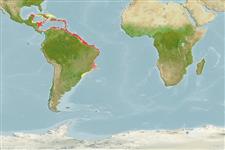Teleostei (teleosts) >
Eupercaria/misc (Various families in series Eupercaria) >
Haemulidae (Grunts) > Haemulinae
Etymology: Haemulopsis: Greek, haimaleos = bloody + Greek, opsis = with appearance (Ref. 45335).
More on author: Steindachner.
Environment: milieu / climate zone / depth range / distribution range
Ecology
Marine; freshwater; brackish; demersal; depth range 26 - 50 m (Ref. 5217). Tropical; 23°N - 34°S, 89°W - 34°W
Western Atlantic: Mexico (Ref. 26938) and the Caribbean coasts both continental and insular to the Antilles and Brazil.
Size / Weight / Age
Maturity: Lm ? range ? - ? cm
Max length : 25.0 cm TL male/unsexed; (Ref. 5217); common length : 20.0 cm TL male/unsexed; (Ref. 5217); max. published weight: 210.00 g (Ref. 9626)
Inhabits coastal waters, over sandy or rocky bottoms. Also found in water with low salinity (Ref. 9626). Feeds on crustaceans and small fishes. Marketed fresh. Minimum depth from Ref. 26912.
Life cycle and mating behavior
Maturities | Reproduction | Spawnings | Egg(s) | Fecundities | Larvae
Oviparous, distinct pairing during breeding (Ref. 205).
Courtenay, W.R. and H.F. Sahlman, 1978. Pomadasyidae. In W. Fischer (ed.) FAO species identification sheets for fishery purposes. Western Central Atlantic (Fishing Area 31), Volume 4. FAO, Rome. (Ref. 3798)
IUCN Red List Status (Ref. 130435)
Threat to humans
Harmless
Human uses
Fisheries: minor commercial; aquarium: commercial
Tools
Special reports
Download XML
Internet sources
Estimates based on models
Preferred temperature (Ref.
123201): 24 - 27.7, mean 26.6 °C (based on 49 cells).
Phylogenetic diversity index (Ref.
82804): PD
50 = 0.5312 [Uniqueness, from 0.5 = low to 2.0 = high].
Bayesian length-weight: a=0.01202 (0.00973 - 0.01485), b=3.00 (2.96 - 3.04), in cm total length, based on LWR estimates for this species (Ref.
93245).
Trophic level (Ref.
69278): 3.6 ±0.2 se; based on diet studies.
Generation time: 1.7 ( na - na) years. Estimated as median ln(3)/K based on 1
growth studies.
Resilience (Ref.
120179): High, minimum population doubling time less than 15 months (Preliminary K or Fecundity.).
Fishing Vulnerability (Ref.
59153): Low vulnerability (23 of 100).
Nutrients (Ref.
124155): Calcium = 206 [38, 418] mg/100g; Iron = 1.29 [0.67, 2.45] mg/100g; Protein = 18.8 [17.0, 20.6] %; Omega3 = 0.267 [0.134, 0.478] g/100g; Selenium = 44.8 [25.3, 85.8] μg/100g; VitaminA = 20.8 [9.7, 43.6] μg/100g; Zinc = 1.51 [1.07, 2.13] mg/100g (wet weight);
